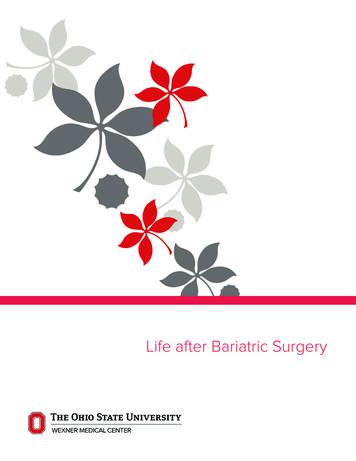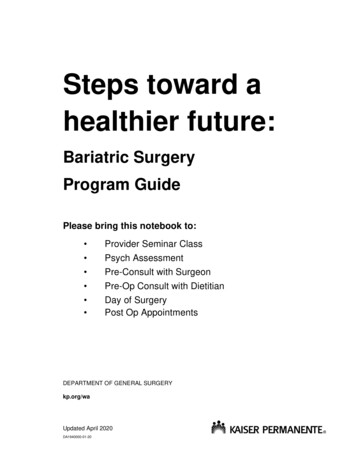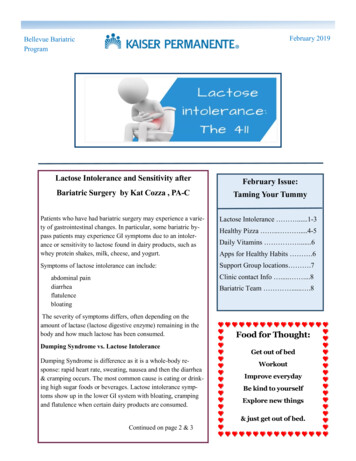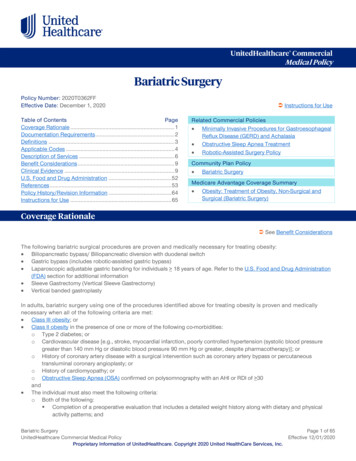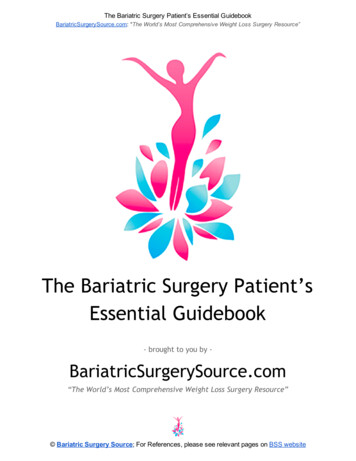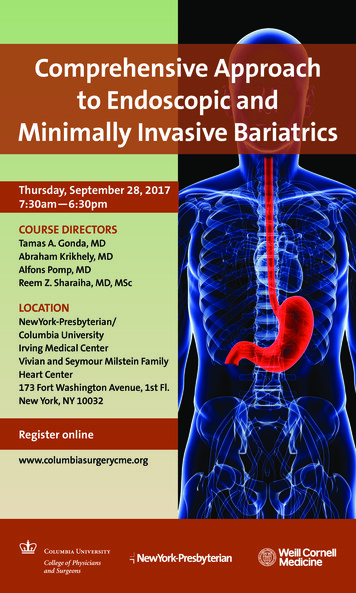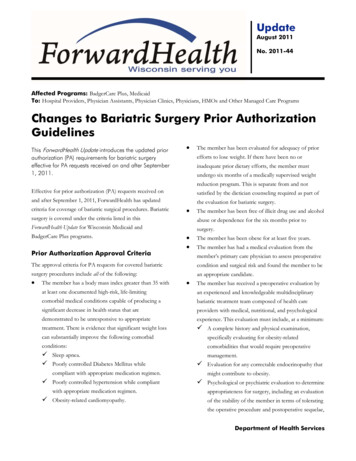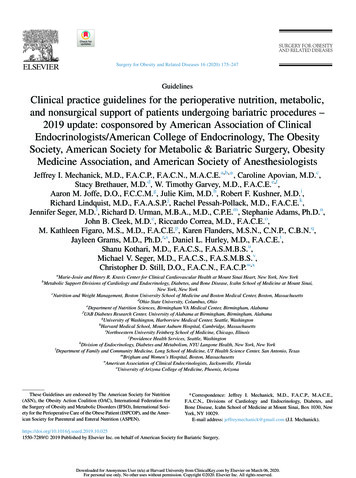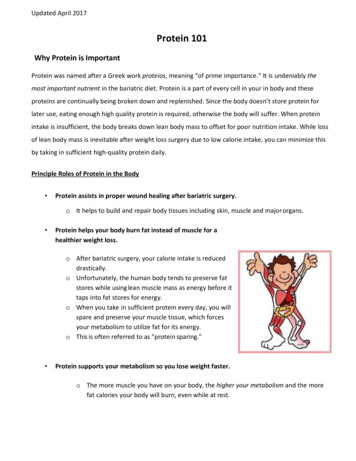
Transcription
Updated April 2017Protein 101Why Protein is ImportantProtein was named after a Greek work proteios, meaning “of prime importance.” It is undeniably themost important nutrient in the bariatric diet. Protein is a part of every cell in your in body and theseproteins are continually being broken down and replenished. Since the body doesn’t store protein forlater use, eating enough high quality protein is required, otherwise the body will suffer. When proteinintake is insufficient, the body breaks down lean body mass to offset for poor nutrition intake. While lossof lean body mass is inevitable after weight loss surgery due to low calorie intake, you can minimize thisby taking in sufficient high-quality protein daily.Principle Roles of Protein in the Body Protein assists in proper wound healing after bariatric surgery.o It helps to build and repair body tissues including skin, muscle and major organs. Protein helps your body burn fat instead of muscle for ahealthier weight loss.o After bariatric surgery, your calorie intake is reduceddrastically.o Unfortunately, the human body tends to preserve fatstores while using lean muscle mass as energy before ittaps into fat stores for energy.o When you take in sufficient protein every day, you willspare and preserve your muscle tissue, which forcesyour metabolism to utilize fat for its energy.o This is often referred to as "protein sparing." Protein supports your metabolism so you lose weight faster.o The more muscle you have on your body, the higher your metabolism and the morefat calories your body will burn, even while at rest.
Protein helps keep you fuller, longer.o Clinical studies show that high-protein diets increase satiety and decrease hungercompared with high-fat or high-carbohydrate diets.o Right after surgery, the majority of patients will not be hungry and may have to bereminded to eat on a regular schedule.o Over time, hunger & appetite can return.o Building a habit of eating protein first will keep you full for longer periods of time,helping you resist the snacking/grazing temptation between meals. Protein helps keep your hair, skin, and nails healthy. Protein helps form hormones, enzymes, and immune system antibodies to help your bodyfunction properly.Protein Goals Protein needs vary with each individual based ontheir age, sex, lean muscle mass, daily exercise, andoverall health.Immediately after surgery the protein goal willrange from40 - 60 grams per day as you are adjusting to asmall stomach and a new way of eating.Once you have transitioned to regular food, thegoal is 60 - 80 grams of high quality protein daily.Protein Shakes & Powders Protein shake and powders are heavily utilized in the immediate months post op to promotewound healing and minimize loss of lean muscle mass.Liquid protein supplements such as shakes and powders are the easiest to take in right aftersurgery. After the first 2-3 months you will incorporate traditional proteins and foods into yourdiet.Many patients continue to use protein shake as a convenient source of protein and nutrition.They are great for a quick and easy breakfast, snack, or as a backup plan when running late andhave no time for a regular meal.
Liquid vs. Solid Proteins As you move into Stage 4 and beyond, you will incorporate more solid proteins into your diet.Seek out sources with more “staying power,” that will keep you fuller for longer periods oftime. Liquid or soft forms, such as protein shakes, yogurt, or cottage cheese, may not keep yousatiated the way a piece of chicken or eggs will.For example:o 4 ½ ounces of chicken and a Premier protein shake bothhave 30 grams of protein.o Yet the chicken will keep you fuller for a longer period oftime than the liquid protein shake. These liquid and softer proteins are still great sources of protein; simply notice if they continueto provide you with the fullness/satiety you want. You may need to add protein powder or other foods such as fruit to help fill you up.Spacing of Your Proteins Since the body cannot absorb more than about 30 grams at once, youwill need to take in protein throughout the day, across multiple mealsor healthy snacks.Foods that are high in protein should always be eaten first duringmeals, in case you feel full quickly and can’t finish your meal.Proceed with Caution For many patients, beef, pork, lamb, and chicken breast can be particularly difficult todigest; though chicken thigh is generally well tolerated.You may want to wait to introduce these proteins until at least 3 months after surgery.Try new proteins on the weekend or evenings in case they have a negative result.Be sure to choose tender cuts and avoid the higher fat (therefore higher calorie)selections.
Complete vs. Incomplete ProteinsProteins and amino acids are used for almost everymetabolic process in the body.Amino acids are the building blocks of protein.For optimal health, there are nine essential amino acids we need from dietary sources.However, not all proteins are alike. As a bariatric patient your primary goal is to get high qualityprotein sources in to meet your nutritional needs.Many people get confused as to what types of proteins they should eat and what is considered agood protein source. Complete proteinsAnimal-based proteins are known as complete proteins because they contain all nine of theessential amino acids your body needs to function properly.BeefPoultryPorkSeafood & FishEggsDairy Incomplete proteinsPlant-based proteins are considered to be incomplete proteins, as they lack one or more of theessential amino acids that your body needs. Beans (i.e. pinto, kidney, garbanzo)Lentils & split peaNuts & seedsGrains & riceVegetablesComplimentary proteinsPlant-based proteins provide some of the amino acids but they need to be combined with other foods(i.e. beans with rice, whole wheat toast with peanut butter) to make a complete protein; known ascomplimentary proteins. After bariatric surgery this is not a good option. Here’s why: plant source proteins are naturallyhigher in carbohydrates or fat and calories while lower in protein than their animal proteincounter parts.
For example:FoodAmountCaloriesProtein gramsBeans & Rice1 cup36012Peanut butter1 level Tbsp.954Nonfat refried beans1 cup18012Walnuts1 cup84020Chicken1 cup23030 The bariatric diet is similar to a Paleo diet, consisting of mainly protein with complexcarbohydrates coming from vegetables, fruits and legumes.Carbohydrates such as rice, breads, crackers, noodles, and cereal need to be avoided.These carbs are not well tolerated after surgery as they can swell up in your stomach and cancause pain and dumping syndrome.Also, the calories from these carbohydrates can add up quickly, push out protein rich foods, andfor many patients, make it easy to slip back into old unhealthy grazing habits.Therefore food combining to create a complete protein is not the best option.Eat complex carbohydrates such as vegetables, fruits, and legumes to maximize nutrition andsatiety.RecommendedAvoid
Vegetarians Following a vegetarian diet is possible after bariatric surgery, though it does take moreeffort and usually is accompanied with a higher caloric intake.Plant-based proteins, other than soy, need to be combined with other sources to meetyour nutritional needs and are naturally higher in carbohydrate and calories, and notalways well tolerated.Soy This legume is the exception to the plant-based protein rule.Soy contains all the essential amino acids necessary forproper nutrition and comes in a wide variety of products,such as tofu, tempeh, and soybeans.Soybeans are 250 calories and 22 grams of protein per cup.See soy handout for more information.Lupini beans These legumes are one the highest sources of plantproteins available, only second to soybeans, withmost of the essential amino acids.These beans have a firm texture and are typicallysoaked in brine for a great salty snack.Lupini beans are 200 calories and 26 grams ofprotein per cup.See lupini handout for more information.Foods Commonly Perceived as High Protein Legumes, nuts and seeds are often viewed as high quality proteins but they are comprisedmainly of carbohydrate or fat and lacking certain amino acids to make a complete protein. While legumes contain a small amount of protein, it’s best to view them as “bonus proteingrams” and not a main protein source. Dairy products are an excellent source of protein when you select the low-fat or nonfat versions,such as cottage cheese and yogurt. Cheese is high in saturated fat, known to raise your “bad” cholesterol, so try using cheese inmoderation to add flavor, rather than a main protein source. Eating legumes, nuts, seeds and dairy products can be a part of a healthy diet; providing flavor,texture, and a variety of nutrients with a few extra protein grams. Eat them mindfully.
Legumes: Legumes include beans, peas and lentils. They are anexcellent source of complex carbohydrates and provide awide range of essential nutrients including dietary fiber,minerals, vitamins, and some protein. Nutritional composition: 27% protein, 70% carbohydrates, and 3% fat. Average per cup: 240 calories per cup and 15 grams of protein.To meet your protein needs post op, you can use soy products, or add a protein powderor cottage cheese to nonfat refried beans, lentil or bean soups. Think of legumes as great complex carbs with “bonus” grams of protein.Nuts & Seeds: Nuts and seeds are rich sources of energy/calories, heart-healthy fats, fiber, plantprotein, vitamins & minerals, and phytochemicals. Nutritional composition: 13% protein, 15% carbohydrate, 72% fat. Average per cup: 800 calories and 25 grams of protein.While nuts and seeds are healthy for your heart, they can be detrimentalto your weight as the calories can add quickly.Use nuts and seeds to enhance the flavor and textureto a meal. Eat sparingly. Dairy: Cheese is a rich source of many nutrients such as calcium, phosphorus, zinc, vitamin A andvitamin B12. Nutritional composition: 23% protein, 6 % carbohydrate, and 70% fat. Average cheese per ounce is 100 calories, 7 grams protein & 6 grams saturated fat.Select the nonfat or low-fat dairy options.
Choosing Your Proteins The calories from the protein sources vary greatly,depending on the fat and carbohydrate content. When choosing protein, look for sources high in proteingrams and low in calories to maximize nutrition and keep calories low for weight loss andmaintenance. A guideline to make this selection easier is: a minimum of 10 grams of protein for every100 calories. The higher the protein grams and lower the calories, the better. This formula will help you assess the quality of the protein source quickly to determine if itis a low, medium or high quality protein source.For example:FoodAmountCaloriesProtein GramsQualityProtein shake1 shake16030highChicken1 ounce509highCottage cheese - 1%1 cup16028highHalibut1 ounce408highString cheese1 ounce808mediumRibeye1 ounce808mediumChicken sausage1 ounce505mediumMozzarella cheese1 ounce856medium-lowAlmonds1 ounce1656lowPeanut butter1 level tablespoon954lowBlack beans1 cup22015lowCheddar cheese1 ounce1157low
Daily Caloric Intake The 10% guideline also applies to your daily calories. For every 100 calories you eat, a minimum 10 grams should be coming from lean, high qualityprotein sources; up to the 60 grams/day. This guideline is designed to keep you focused in taking in enough protein each day whilekeeping your calories low to maximize your weight loss. Weight loss may slow down or stop once daily calories are 1000 or more per day dependingon the individual.For example:Average Caloriesper DayAverage ProteinGrams per DayHigh proteinto low calorie in Needs Your protein needs will vary with each individual though the general goal is 60 - 80 grams of highquality protein daily.Protein needs to be spread out throughout the day with your meals and snack(s).Add up the protein: 15 - 20 grams per meal/snack x 4 meals 60 to 80 grams of protein/dayFor oriesProtein Grams1% cottage cheese andpineappleDeli ham &LF string cheesewrapped in lettucePB2 and½ appleChicken thighBroccoli¾ cup2 oz.3 oz.1 oz.1 oz.2 Tbsp.4 oz.3 oz.½ cup1201490701456018025210158050222Total60573
Tracking Protein IntakeFood recordsKeeping a food journal is essential to track your progress andensure you are meeting your required protein needs.Records will also help you track which foods are best toleratedand which proteins to avoid.Food records include: the time, food, amount, calories, and protein grams, any intolerances,and hunger/fullness levels.It’s also helpful to note your mood/feelings, location, and who you are eating with.Keeping a food journal allows you to review your progress and assess the best proteins,foods, and amounts to keep you fueled, full and satisfied. Weigh and measure Weigh and measure your proteins on a kitchen scale often to ensureaccuracy of your protein intake.Many patients overestimate their daily protein grams when they rely on“eye-balling” their protein quantity.Using a scale and keeping food records are critical tools for success.If you find you are getting hungry quickly after a meal, there are several factorsthat may explain this: The carbs you are eating are quickly utilized burned up, leaving your hungrier faster.The protein source was in a liquid or soft form (i.e. protein shake or yogurt).You didn’t eat enough protein grams at the meal (i.e. 1 oz chicken vs. 3 oz chicken)You didn’t eat enough quantity of protein with complex carbs to last very long.You’ve gone too long between meals and need to refuel your body.Tips: Eat proteins first and choose high quality protein sources.Have the majority of your carbohydrates come from vegetables and fruits.Eat at regular meal times, do not skip meals.Track the meals that provide you the most satiety and enjoyment.Continue to expand the variety of proteins and foods you eat to increase nutrition andenhance enjoyment.
Pureed Meal Ideas (Stage 3)ALL FOODS need to be pureed to the consistency of applesauce; smooth with no chunks. Yourstomach is still healing and solids foods can cause dumping syndrome or pain.Start slowly, with about 1/4 - 1/3 cup of food. Listen to your body and stop when full. Gradually increasequantity as tolerated. Use herbs and spices to flavor the proteins. Remember to take dime-sized bitesand sips to prevent eating too fast or too much.Meat, Fish, Poultry Chicken thigh with taco seasoningCanned tuna mixed with cottage cheese and dillShrimp with cocktail sauceChicken thigh with PB2, cilantro, and coconut extract (Thai chicken)Eggs, Cheese, Dairy Soft scrambled eggs with pico de gallo (liquid only)Laughing cow cheese with deli ham & mustardNonfat plain Greek yogurt with mashed peaches (no skin)Cottage cheese blended with bleu cheese and chickenSoups (with protein added)* Tomato soup with cottage cheese and basilButternut squash soup with tofu and Creole seasoningLow fat mushroom soup with unflavored protein powder and ItalianseasoningFat free refried beans with cottage cheeseFruits/Vegetables Mashed melons, pears, peaches, nectarines, bananasMashed sweet potatoes, butternut squash, broccoli or cauliflower.*Soups and legumes are primarily a carbohydrate source. Make sure to puree them with unflavoredprotein powder, cottage cheese, or tofu to decrease the grams of carbohydrates and ensure you aretaking in protein.
Cottage Cheese Recipes (Stage 3 and Beyond)Blue cheese dip/dressing 1 pint nonfat or low fat (1%) cottage cheese 1 ½ oz. blue cheese 1-3 cloves of garlic- to taste Splash of Worcestershire sauce - to taste Salt & pepper – to taste Nonfat milkPlace all of ingredients in blender or food processor.Add enough milk to your desired consistency.It can be used as dip, sauce or dressing.For ¼ cup*65 calories8 protein grams*based on 1% fat cottage cheeseRanch dip/dressing 1 pint nonfat or low fat (1%) cottage cheese 1 packet Uncle Dan’s Ranch or Hidden Valley seasoning Nonfat milkPlace all of ingredients in blender or food processor.Add enough milk to your desired consistency. It can be used as dip,sauce or dressing.For ¼ cup*45 calories7 protein grams*based on 1% fat cottage cheese* If using Hidden Valley seasoning packet it is 65 calories for ¼ cup.Note: you could also substitute the cottage cheese with nonfat plain Greek yogurt, light ricotta cheeseor tofu; though cottage cheese will provide the best calorie to protein ratio.
Protein Meal and Snack Ideas (Stage 5 and Beyond) To keep meals simple and your protein intake high, create a list of 2 - 4 menu ideas for eachmeal that you enjoy, are high protein, and well tolerated.This approach provides structure, standard items on your grocery list and enough variety toprovide proper nutrition and optimum enjoyment.Breakfast: Cottage cheese or yogurt with fruitEgg & veggie scrambleProtein shakeEgg bites - eggs, veggies, low-fat cheese and turkey bacon,ham or chicken sausage baked up in muffin tins for a quick and easy breakfast.Chicken sausage (Flavors: garlic herb, sweet Italian, Andouille, pesto, hot Italian, etc.)Veggie-loaded breakfast casserole: eggs, spinach, mushrooms, onion, bell peppers,cheese. Add a chicken sausage for extra flavor & protein.Ham, egg and cheese roll ups – with spinach and tomato.Lunch: Deli meat (ham, chicken, turkey, or lean roast beef) wrapped around string cheese. Dip ingourmet mustard.Soups- a flavorful way to get in your protein with lots ofvegetables (i.e. Chicken Fiesta soup, Indian Stew, ChunkyTurkey Vegetable soup).Small green salad topped with shredded chicken, shrimp or hardboiled egg.Leftovers from dinner of lean meat and veggies.Mini meatloaf – bake in a muffin tin for just-right-sized meals.Garlic parmesan chicken thighs.Beef & Broccoli Stir fry with Cauliflower RiceBuffalo chicken salad: chicken, Cajun hot sauce, baby spinach,cherry tomatoes, onions, cilantro cottage cheese ranch dressing.
Dinner: Chicken sausage & mushroom pizza bowls - with marinara, low fat mozzarella cheeseand Italian seasoning blend.Ground turkey taco wraps - with pinto or black beans, low fat cheese, tomatoes, onion,cilantro and iceberg lettuce.Baked salmon with avocado salsa and broccoli.Grilled halibut with garlic cilantro sauce and asparagus.Stuffed bell peppers - lean ground turkey or beef, blackbeans, spices and topped with low-fat cheese and greenonions.Meat & veggie spaghetti sauce over zucchini or spaghettisquash.Buffalo Chicken Zucchini Boats: chicken, monetary jack cheese, cottage cheese ranchdressing, zucchini, and hot sauce. Optional garnish: sliced red onion, fresh cilantro,avocado slices.Ground Beef Enchilada Zucchini Boats: ground beef, taco seasoning, onion, zucchini,enchilada sauce, cheese, & cilantro.Dessert: High protein pudding: nonfat plain Greek yogurt, chocolateprotein powder, stevia drops, milk. If you want theconsistency of ice cream, freeze it for minimum of 1 hour.Low fat ricotta cheese whipped with stevia and fruit. Freeze fora minimum of one hour.Apple slices dipped in PB2.Finding recipes There are many online resources to find new high protein recipes and ideas.Searching for bariatric friendly or Paleo recipes on bariatric support sites, Google, or Pinterestcan be a great starting place.Remember that not all recipes labeled as bariatric-friendly will be appropriate for you to makeor eat.Be sure you choose ones that are in alignment with your bariatric team’s recommended dietaryguidelines.
Protein ChartThis list of protein sources is based on averagecalories per ounce, cup, or level tablespoon.Both calories and protein grams were roundedup or down for ease of use.BEEFCalories Proteinper oz. gramsBologna903Beef jerky8015Beef Top Round509Brisket907Flank558Ground beef (93% lean)406(85% lean)708(80% lean)707Hot dog903Pastrami406Pot Roast909Prime Rib705Ribeye707Ribs1006Roast Beef508Salami - soft754Salami - hard1106Shank6010Skirt steak657Summer Sausage1005T-bone507Top Loin (NY Strip)656DAIRY - low fat optionsCalories Proteinper cup gramsFoodCottage cheese1%2%4%Greek yogurt: NF, plainYogurt: NF, anadian baconChickenCorned toRoast beefSalamiTurkeyCaloriesper 667545
FISH & rMusselsOystersSalmonSmoked salmonjerkyScallopsShrimpTilapiaTuna fish(can or pouch)POULTRY – continuedCaloriesper ghwinggroundChicken sausageEgg (large)Cornish game henCaloriesper breastdrumstickthighwinggroundturkey baconturkey jerkyDuckGooseGoose liver patePheasantCaloriesper 9Caloriesper 1445777546948881006955547PORKFoodBaconBlood sausageBolognaBratwurstCanadian baconChorizoGround porkHam steakPancettaPepperoniPork chopsPork liverwurstPork loinPork roastPork ribsPork sausage –bulk, link or pattyPork & beef salamiProsciutto
SOYFoodsoy beans - dryroastedSoybeans- shelledTofu – firmTofu - softTempehCaloriesper cupProteingrams5205625017515035022211631DAIRY & PLANT-BASED PROTEINSPlant-based and higher fat dairy proteinsare typically higher calorie and lower inprotein.Choose eam cheese - regularCream cheese - low fatCream cheese - fat freeFetaGoudaHavartiLaughing Cow – regularLaughing Cow – lightMascarponeMonterey JackCalories Proteinper oz. 12521007CHEESE – continuedFoodMozzarella - whole milkParmesanPepper JackProvoloneRicotta - lightRicotta - part skimRicotta - wholeSwissCalories Proteinper oz. AdzukiBlackCannelliniFavaGarbanzoGreat NorthernLimaLupini beansNavyPintoNF refried beansRed kidneyPeasBlack-eyedSplit peasLentilsSoybeansCaloriesper 017151414111912262012181618523023025011161822
NUTS & eanutsPecansPine SesameSunflowerCaloriesper UT BUTTERSFoodAlmondBrazilCashewFlaxHazelnutHemp seedMacadamiaPB2 (2Tbsp)PeanutPecanPistachioPumpkin seedSesame seedSoynutSunflower seedWalnutCaloriesper eingrams4222250542333433
YogurtYogurt is a very healthy protein option depending on the individual and type of yogurt you eat.There are many yogurts with high protein and low sugar and there is just as many with high sugarand low protein. You will need to read the labels carefully to determine if the yogurt meets yournutritional needs. Yogurt label reading guideline: for every 100 calories, a minimum of 10 grams ofprotein, and 7 grams of sugar.Try buying plain, nonfat yogurts and adding sugar free syrups or protein powders to flavor them.Recommended YogurtsYogurtCaloriesProteinSugarDannon Oikos Nonfat Plain Greek80156Chobani Nonfat Greek80154Stonyfield Organic Greek, Nonfat, Plain80156Siggi’s 0% Nonfat Plain80154Fage Total 0% Plain Greek100187Nancy’s Nonfat Plain Greek120227Carb Master (Kroeger) average all flavors80123Dannon Activia Greek Light VanillaNonfat80136Yoplait Greek 100 Vanilla100136Dannon Light & Fit Nonfat Greek average all flavors120157Dannon Oikos Triple Zero average all flavors120157
SoySoy is in rich in vitamins, minerals, calcium, iron, fiber, phytochemicals, and protein.Studies have found soy can help prevent and improve some of today’s top health issues such as heart disease, high blood pressure, osteoporosis, certaincancers; and menopausal symptoms like hot flashes, night sweats, and insomnia.Soy foods are popular with vegetarians and vegans who often rely on them for their main source of protein; as soy contains all of the essential amino acids.Soy is very versatile and can be eaten as whole beans (edamame) or processed as tofu, tempeh, soy yogurt, miso, soy milk and other soy-based products.ProductAmountCaloriesProtein GramsSoy beans: shelled1 cup25022Soy nuts: dry roasted1 cup52056Soy cheese1 oz707Soy milk1 cup906Soy powderedprotein: unflavored¼ cup7017Soy yogurt1 cup1406Tempeh1 oz606Tofu: firm1 oz303soft1 oz202silken1 oz151.5Types of Tofu Firm: is dense and can be cubed and stir-fried, grilled, scrambled, pickled, smoked,baked, barbecued or served in soups. Firm tofu is higher in protein, fats and calcium thanother types of tofu.Soft: is better suited for recipes in which tofu needs to be blended.Silken: has a creamy structure and is also used in blended dishes.
Lupini BeansLupini beans are large, flat, round, yellowish seeds in the legume family, native to Italy.They are traditionally eaten as a pickled snack food, in the Mediterranean basin andLatin America.Lupini are commonly sold in jars; brined like pickles or olives.They have a thick outer skin that needs to be torn to get to the bean; though you can eat theskins too.Highly skilled lupini eaters learn to split the skin by rubbing the bean between forefinger andthumb; popping it directly into their mouth.They are a nutritious snack when you want something salty and “crunchy” to eat. Lupini bean facts: One of the highest sources of plant proteins available after soybeansThe bean skin consists mainly of cellulose (insoluble bran fiber)Rich in antioxidants and amino acids, especially arginineHave a low glycemic index; great for diabeticsEasy to digest and high bioavailabilityHigh in vitamins, especially B complex, and mineralsLow in fat, cholesterol, and is gluten freeProbiotic food, promoting the growth and nurturing of “good” gut bacteriaNutritional composition: 45% protein34% carbohydrates21% fat
Cooking Lupini BeansThese delicious beans are a healthy protein snack but they do require a bit of patienceto prepare.1. Pick over beans to remove any debris.2. Put the beans in the pot of water and soak overnight for 24 hours. Be sure that thewater covers the beans totally. After twelve hours, check on the beans to makecertain they’re completely immersed and add more water if required.3. After the 24 hour period of soaking, drain the water and refill with fresh watercovering the beans completely.4. Bring the beans into a boil as well as simmer for 1 ½ hours. Add more water if needed.5. Drain, rinse well, and cover with salted water (about one tablespoon per quartof water).6. Allow them to cool and then refrigerate.7. Repeat this process twice a day for 7 days or until the soaking brine is no longer bitter.8. Store the beans in air-tight container within the fridge. They’ll keep for about 6 weeks.Where to BuyDried: Amazon, Nuts.comPrepared: Amazon, Walmart.com, Luckyvitamin.com
Updated April 2017 Protein 101 . Why Protein is Important . Protein was named after a Greek work proteios, meaning “of prime importance.”It is undeniably the most important nutrient in the bariatric diet.Protein

